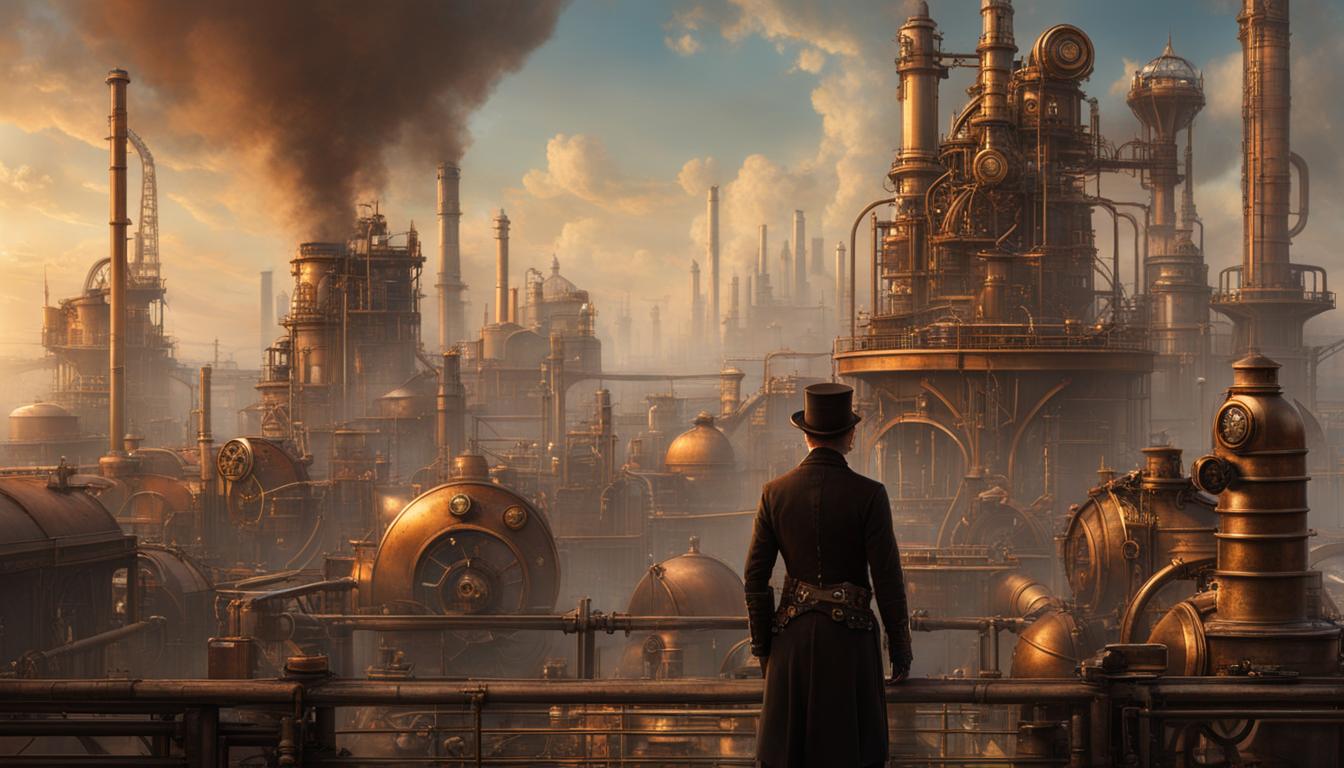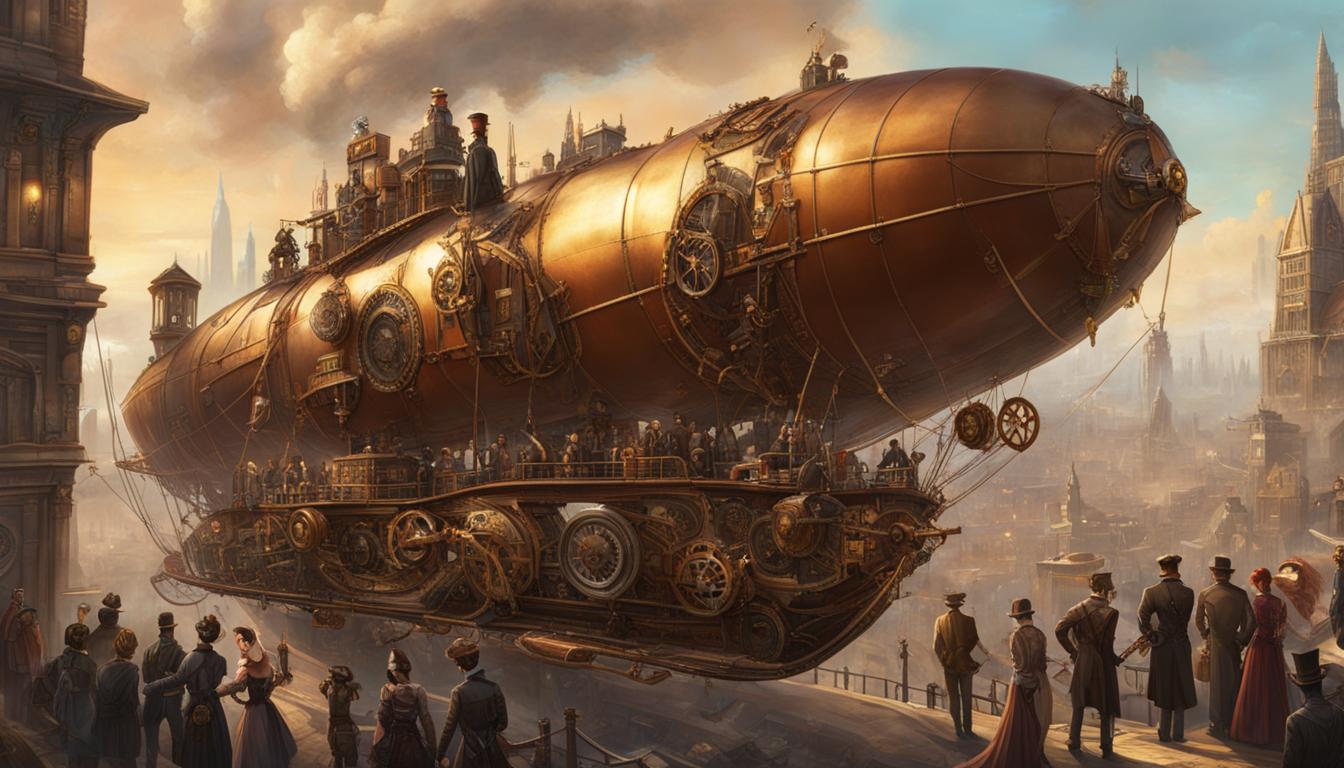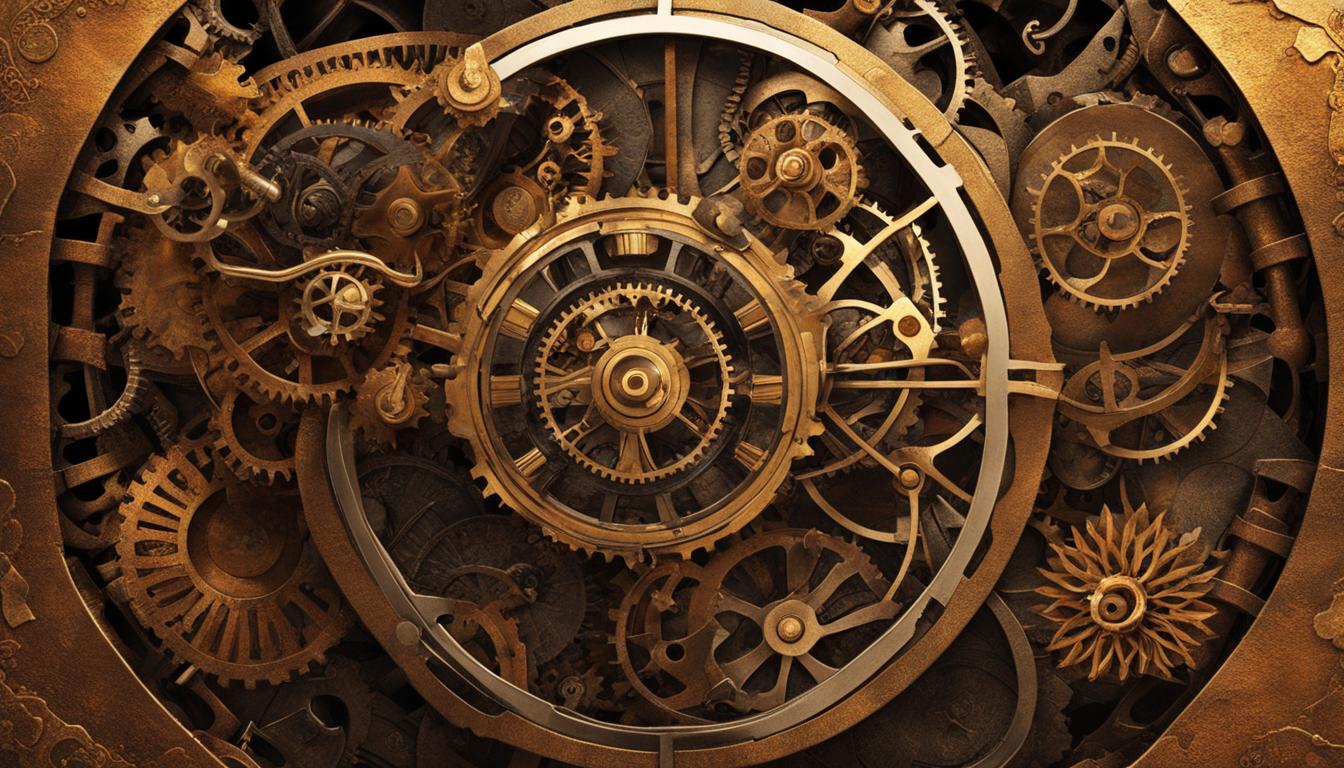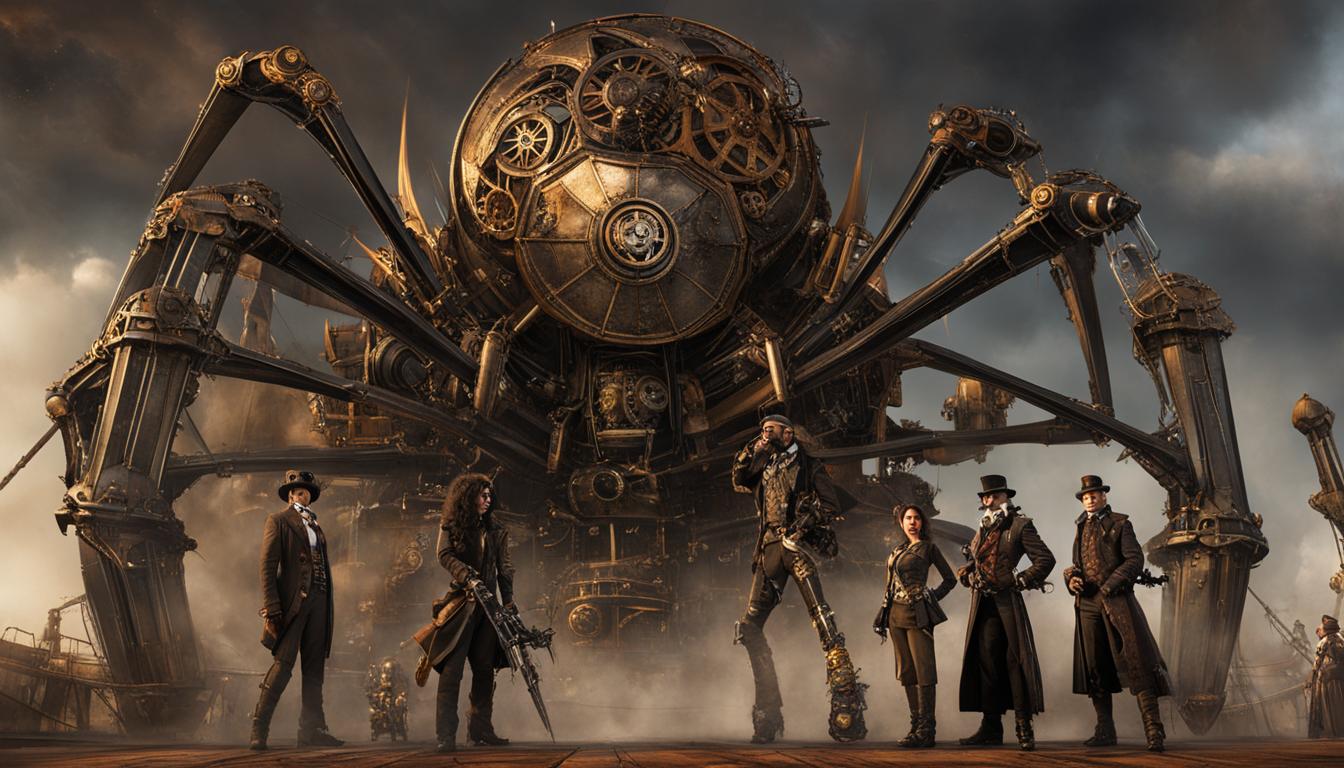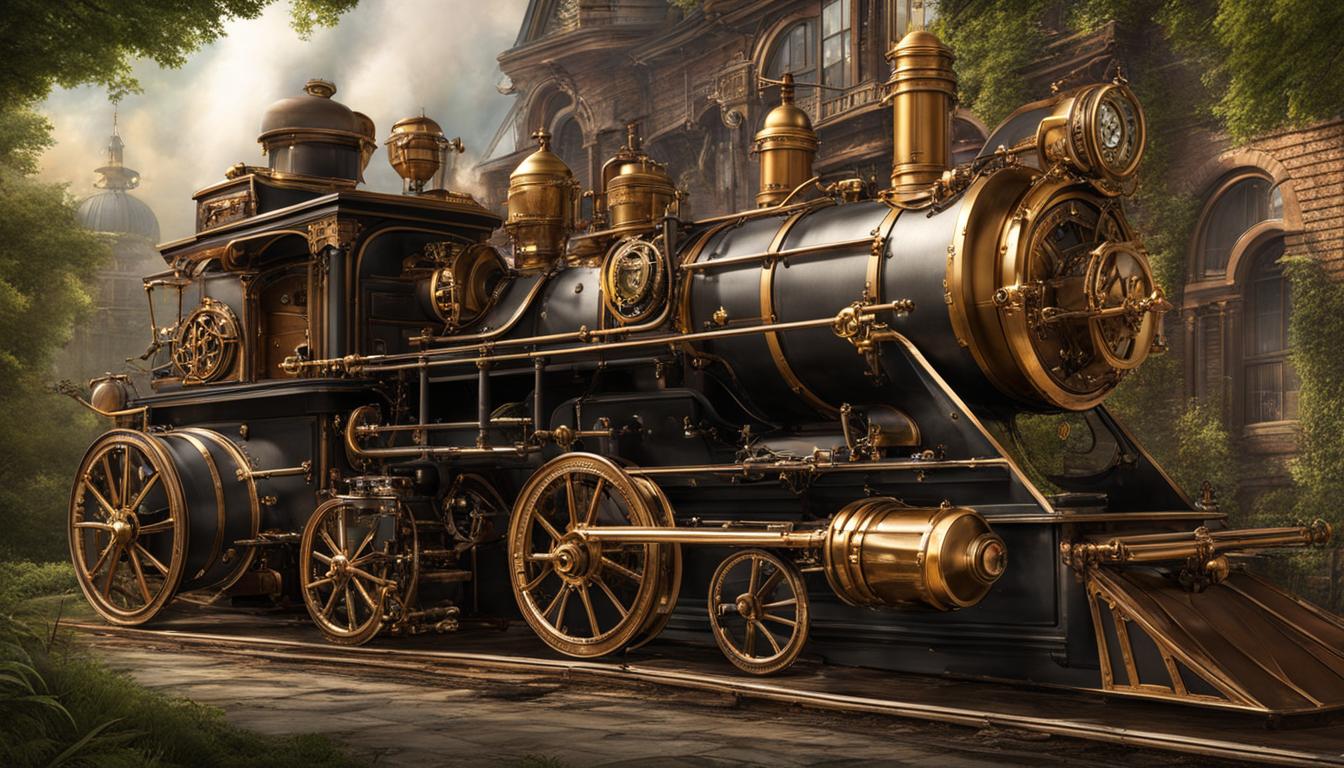Steampunk, the captivating subculture that fuses retrofuturistic technology, Victorian elegance, and the mystique of the American Wild West. Picture a world where steam power reigns supreme, envisioning an alternative future known as retrofuture. This alternate history is characterized by the mesmerizing influence of steam-powered machines and the aesthetic marvels inspired by the Industrial Revolution of the 19th century. But it goes beyond mere appearance – the ethos of steampunk is driven by the transformative power of steam technology.
Steampunk is not a fleeting trend; it is a multidimensional movement that manifests itself in various aspects of life. From visual iconography to literature, music, fashion, and even political activism, the impact of steam technology is undeniable. It embodies resistance, transgression, and a singular way of looking at history, challenging our perception of what could have been.
Key Takeaways
- Steampunk imagines a retrofuture world where steam power remains dominant, creating an alternative history.
- Steam-powered machinery influences every aspect of steampunk, from its visual aesthetics to its literature and music.
- The intricate fusion of Victorian elegance and visible machinery defines the captivating fashion of steampunk.
- Steampunk explores societal transformations resulting from unchecked steam technology, offering critical reflections on gender, class, and politics.
- Ethical implications of steam technology in steampunk narratives prompt examination of power dynamics and responsibility.
The Evolution of Steam Tech in Steampunk Fiction
Steampunk fiction draws inspiration from the works of Jules Verne and H.G. Wells, who are considered its earliest progenitors. It envisions a world where steam-powered technology is ubiquitous, combining Victorian aesthetics with speculative or adapted technologies. Steampunk literature explores alternate histories, social commentary, and blends elements of fantasy, horror, and historical fiction.
The use of steam-powered machinery in these fictional worlds evokes a sense of romanticism and nostalgia for the industrial might of the steam era. The juxtaposition of disparate historical contexts with speculative technologies serves as a form of “ethical spectacle” that represents resistance and transgression.
“Steampunk literature invites readers to explore a world where steam power reigns supreme, capturing the imagination with its romanticized visions of a bygone era,” says renowned steampunk author, Amelia Whitlock.
Steampunk authors often infuse their narratives with intricate descriptions of steam-powered machinery, such as steam engines, airships, and automatons. These mechanical marvels become characters in themselves, adding depth and complexity to the stories. By harnessing the power of steam, these fictional worlds take readers on thrilling adventures and explore the potential consequences of unchecked technological progress.
The Romanticism of Steam in Steampunk Culture
The romanticism of steam in steampunk culture is deeply rooted in a fascination with the industrial revolution and its iconic machinery. Steampunk enthusiasts often incorporate steam-powered aesthetics into their fashion, accessories, and artwork, paying homage to the ingenuity and craftsmanship of the steam era.
According to Dr. Victoria Dupont, a cultural historian specializing in steampunk, “The romanticism of steam in steampunk culture reflects a longing for a simpler, more tactile world. It celebrates the beauty of mechanical devices and the craftsmanship involved in their creation.”
From intricate pocket watches to elaborate corsets adorned with gear motifs, steampunk fashion embraces the visual language of steam-powered machinery. This aesthetic extends beyond the realm of fashion, permeating steampunk art, design, and even music. The hissing of steam, the rhythmic churning of gears, and the nostalgic aura of the steam era are all celebrated in the creative expressions of the steampunk subculture.
Table: Evolution of Steam Tech in Steampunk Fiction
| Steampunk Novel | Influential Themes | Notable Steam-Powered Technologies |
|---|---|---|
| The Difference Engine by William Gibson and Bruce Sterling | Alternate history, political intrigue | Analytical engine, difference engine |
| Leviathan by Scott Westerfeld | Steampunk meets biopunk, war and diplomacy | Living airships, fabricated creatures |
| The Iron Council by China Miéville | Social revolution, resistance | Perpetual train engine |
| Boneshaker by Cherie Priest | Zombie apocalypse, frontier adventure | Steam-powered drilling machine, gas masks |
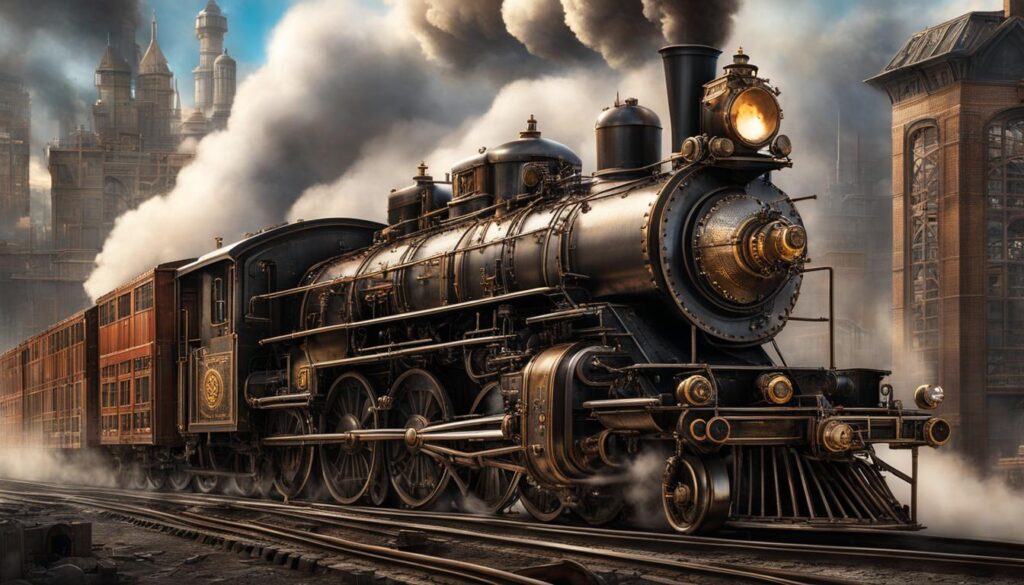
In steampunk, the aesthetics of steam-driven machinery serve as a reflection on the industrial might of the steam era. Gears, cogs, hydraulics, and engines are prominently displayed, reminiscent of the intricate clockwork mechanisms of the 19th century. This fascination with melding machinery and organic life is evident in the incorporation of automata-inspired designs, adding an element of fantasy to the aesthetic.
Steampunk Fashion: A Showcase of Mechanical Marvels
Steampunk fashion is a visual feast for the eyes, combining the elegance of Victorian attire with the mechanical marvels of the steam era. Corsets, top hats, goggles, and waistcoats are common elements, often adorned with gears and mechanical trinkets. Accessories such as pocket watches, compasses, and even ray guns further enhance the aesthetic, transporting enthusiasts to an alternate reality where steam-powered technology reigns supreme.
Through its distinctive aesthetic, steampunk offers a unique perspective on the possibilities of steam-driven machinery and its impact on society. It invites us to reflect on the relationship between technology and culture, while simultaneously captivating our imaginations with its retrofuturistic allure.
Societal Transformations Due to Steam in Steampunk
In the world of steampunk, the impact of steam technology goes far beyond the realm of fiction. It has the power to transform entire societies, leading to both utopian visions and dystopian nightmares. Steampunk stories often depict steam-driven dystopias, where the unbridled advancement of steam technology has dire consequences for social equality, the environment, and personal freedom. These tales serve as cautionary reminders of the potential pitfalls of unchecked technological progress.
One of the key societal transformations explored in steampunk is the role of steam technology in shaping gender norms, class dynamics, and political structures. By envisioning an alternative history where steam power remained dominant, steampunk offers a critique of the Victorian era and its values. It challenges traditional notions of gender and class, presenting opportunities for the empowerment of marginalized groups and the reimagining of social hierarchies.
What makes steam power an intriguing element of the steampunk genre is its ability to reflect real-world concerns about industrialization, capitalism, and the consequences of human ambition. Through steam-driven dystopias, steampunk confronts us with the potential dangers of placing too much faith in technological progress without considering its ethical implications. It prompts us to question our own relationship with technology and the responsibility we bear in its creation and use.
| Steam-Driven Dystopias in Steampunk Stories | Societal Transformations Due to Steam in Steampunk |
|---|---|
| 1. The City of Cogs: In this steampunk tale, the city is powered entirely by steam, with towering smokestacks dominating the skyline. However, the working class suffers under oppressive living and working conditions, while a wealthy elite enjoys the benefits of steam-powered luxury. | 1. Gender Equality: Steampunk challenges traditional gender norms, depicting strong and empowered female characters who defy societal expectations. It explores the potential for gender equality in a world driven by steam technology. |
| 2. The Clockwork Rebellion: In this steampunk adventure, steam-powered automatons have taken over society, leaving humans oppressed and enslaved. The protagonist leads a rebellion against the machines to restore freedom. | 2. Class Revolution: Steam technology in steampunk often fuels class conflicts and revolutions. The lower classes seek to overthrow the ruling elites who control the means of steam power production, leading to societal transformations and power shifts. |
| 3. The Smoggy Skies: In this steampunk world, the unrestrained use of steam technology has led to severe environmental pollution. The skies are perpetually darkened by thick smog, causing health issues and a loss of natural resources. | 3. Political Upheaval: Steampunk explores the political implications of steam technology, with movements and ideologies emerging around steam power. It delves into questions of political power and governance in a society driven by steam. |
In conclusion, steampunk serves as a vehicle for exploring the societal transformations that could have occurred if steam power had remained dominant. Through steam-driven dystopias, it highlights the potential consequences of unchecked technological progress, offering a critique of our own world and the ethical responsibilities that come with creating and using steam-powered machinery.
Ethical Implications of Steam Technology in Steampunk
Steampunk, as a subculture that celebrates the industrial might of the steam era, raises thought-provoking questions about the ethical implications of steam technology. In many steampunk stories, the unbridled use of steam-driven machinery is depicted as potentially oppressive, leading to steam-driven dystopias. The power dynamics between those who have access to steam technology and those who do not are examined, highlighting themes of privilege, control, and resistance.
One of the key ethical concerns explored in steampunk is the role of steam-powered machinery in shaping society and individual freedom. Steampunk stories often depict a world where the unchecked advancement of steam technology has led to social inequality, environmental degradation, and a loss of individual autonomy. By presenting steam-driven dystopias, steampunk serves as a cautionary tale, reminding us of the potential consequences of technological progress without proper ethical consideration.
“In a steam-driven dystopia, the relentless pursuit of progress often comes at the expense of human rights and environmental sustainability,” says Dr. Jane Hawking, a steampunk literature expert. “Steampunk offers a critical lens through which we can examine the balance between technological innovation and the preservation of our shared values.”
Moreover, steampunk encourages us to reflect on our own relationship with technology and the responsibilities that come with creating and using steam-powered machinery. It reminds us to consider the impact of our actions and the potential consequences they may have on society and the environment. Steampunk serves as a thought-provoking reminder that progress should not be pursued at the expense of ethics and human well-being.
Table: Comparing Steam-driven Dystopias in Steampunk Stories
| Steampunk Story | Key Ethical Themes |
|---|---|
| “The Steam City Chronicles” | Class inequality, labor exploitation, and the loss of personal freedom |
| “Clockwork Uprising” | Environmental degradation, the dehumanization of society, and resistance against oppressive steam-powered governments |
| “The Brass Rebellion” | Gender inequality, the impact of steam technology on gender roles, and the struggle for equality |
| “The Iron Empire” | Political corruption, manipulation of steam technology for control, and the fight for democracy |
By exploring the ethical implications of steam technology, steampunk offers a unique and engaging platform for discussions about the impact of technology on society. It serves as a reminder that advancements in technology should always be accompanied by a critical examination of their potential consequences, allowing us to navigate a future where progress is balanced with ethical considerations.
Conclusion
Steampunk, with its mesmerizing blend of retrofuturistic aesthetics and alternative histories, has undeniably been shaped by the revolutionary impact of steam technology. This unique subculture invites us to explore a world where steam power remained dominant, offering a creative and imaginative reflection on what could have been. The impact of steam technology on steampunk’s ethos is profound, evident in its visual iconography, literature, music, fashion, and even political activism.
Steampunk’s fascination with the industrial might of the steam era is evident in its romanticism of steam-driven machinery. The incorporation of gears, cogs, and engines in fashion and design pays homage to the automata of the 19th century, evoking a sense of sophistication and elegance. The subculture’s aesthetics not only reflect a reflection on the industrial might of the past but also serve as a critique of modern technology’s impersonal designs.
Moreover, steampunk delves into the ethical implications of steam technology, provoking us to question the consequences of its unbridled use. By examining power dynamics, social inequality, and control in steam-driven dystopias, steampunk offers a critique of the potential oppressive nature of technology’s advancement. Through the provocative juxtaposition of history and technology, steampunk reminds us of the ever-present need to consider the ethical responsibilities that come with creating and utilizing steam-powered machinery.
In essence, steampunk is more than a consumer trend; it is a multidimensional movement that represents resistance, transgression, and a unique way of “doing” history. By reflecting on the impact of steam technology, this subculture invites us to reflect upon our own relationship with technology and the potential consequences of its unchecked advancement. Steampunk’s enduring appeal lies in its ability to captivate our imagination while challenging societal norms, offering a glimpse into the past through the lens of an alternative future.
FAQ
What is steampunk?
Steampunk is a subculture that combines elements of retrofuturistic technology, the Victorian era, and the American Wild West. It imagines a world where steam power remained the dominant energy source, creating an alternative future known as retrofuture.
What is the impact of steam technology on steampunk’s ethos?
The impact of steam technology on steampunk’s ethos is evident in its visual iconography, literature, music, fashion, and even political activism. Steampunk represents resistance, transgression, and a unique way of “doing” history.
Who are the earliest progenitors of steampunk fiction?
The works of Jules Verne and H.G. Wells are considered the earliest progenitors of steampunk fiction.
How does steampunk explore alternate histories?
Steampunk literature explores alternate histories, social commentary, and blends elements of fantasy, horror, and historical fiction. It envisions a world where steam-powered technology is ubiquitous, combining Victorian aesthetics with speculative or adapted technologies.
What is the visual aesthetic of steampunk?
The visual aesthetic of steampunk is characterized by the fusion of Victorian fashion with uncovered and visible machinery, often referred to as open-faced clockwork. Gears, cogs, hydraulics, and engines are prominently displayed in steampunk fashion and design.
What societal transformations does steampunk explore?
Steampunk explores the societal transformations that would have occurred if steam power had remained the dominant energy source. It examines the role of steam technology in shaping gender norms, class dynamics, and politics, offering a critique of Victorian society and its values.
What are the ethical implications of steam technology in steampunk?
Steampunk delves into the ethical implications of steam technology by exploring the consequences of its unbridled use. It examines power dynamics, privilege, control, and resistance, raising questions about the ethical responsibilities that come with creating and using steam-powered machinery.

